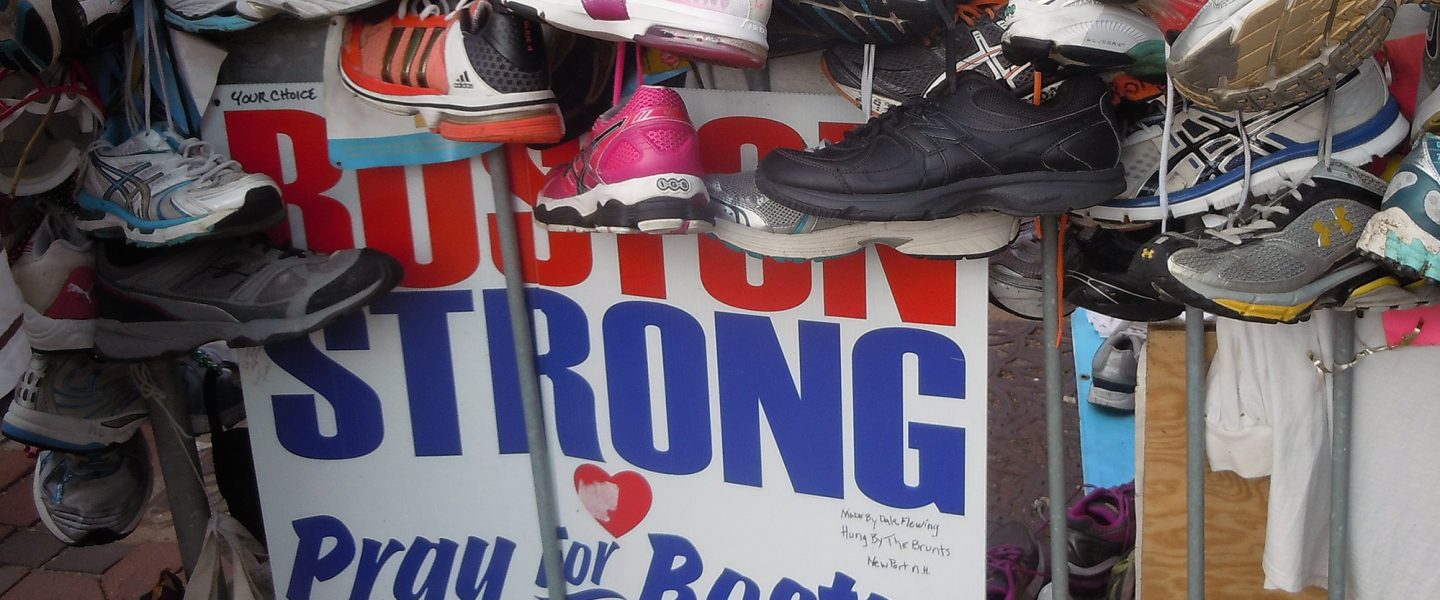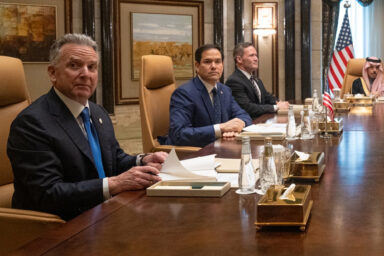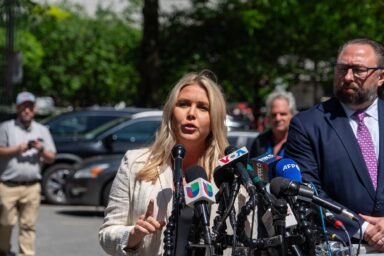A selection of the dozens of articles we produced in the aftermath of the Boston Marathon bombing and during the trial of Dzhokhar Tsarnaev. Many of the questions we asked remain unanswered to this day.
|
Listen To This Story
|
Ten years ago today, two bombs close to the finish line of the Boston Marathon killed three people and injured hundreds — many of them severely.
What happened next was unprecedented in US history. While the nation watched with bated breath, Boston was essentially shut down. Thousands of law enforcement personnel participated in a door-to-door search for the perpetrator(s), whom the authorities eventually identified as the brothers Dzhokhar and Tamerlan Tsarnaev.
The story had all of the ingredients of a drama destined to keep Americans glued to their screens for days: terrorism, Muslim bombers, a shootout, heroes, a city that emerged “Boston Strong,” and, most importantly, a happy end.
Tamerlan Tsarnaev died following the shootout while his brother Dzhokhar was captured later, tried, and sentenced to death.
It was such a good story that not many people asked whether the narrative that the authorities presented, and that was repeated by most of the media, was the truth, the whole truth, and nothing but the truth.
But WhoWhatWhy did.
And it quickly became apparent that, at the very least, there were some questions that should have been asked and were not. During the coverage of the bombing, and then during the trial of Dzhokhar, lots of information was withheld and inconsistencies were glossed over.
That is not to say that the Tsarnaevs were not the perpetrators of the bombing. They very likely were. However, it is also true that we were not told the whole story.
What role did Tamerlan Tsarnaev’s previous contact with the FBI play? Is it at least possible that he was one of the young Muslims targeted to serve as informants or to participate in a fake terrorist plot hatched by the bureau itself to show the US was making headway in the “War on Terror?” What exactly happened a month later when an FBI agent killed a friend of Tamerlan Tsarnaev? And why, if the brothers acted as “lone wolves,” were special administrative measures put in place that severely restricted Dzhokhar Tsarnaev’s ability to communicate with the outside world — ostensibly to prevent him from talking to accomplices which the government said didn’t exist?
These are just some of the many unanswered questions that the mainstream media should have asked but didn’t. Instead, it was a small nonprofit news organization with a tiny budget that used forensic journalism to point out many of the inconsistencies in the accepted narrative.
In addition to having been among the first to raise the issue of election integrity, our coverage of the Boston bombing was one of WhoWhatWhy’s finest hours.
And, naturally, we were maligned for simply asking questions, though that is precisely what journalists should do.
Below, you will find a selection of the dozens of articles we produced in the aftermath of the bombing and during the trial of Dzhokhar Tsarnaev. Many of the questions we asked remain unanswered to this day — often for no good reason.

The Marathon Bombing: What the Media Didn’t Warn You About (04/19/2013)
The bombing at the Boston Marathon provides a perfect example of the defects of conventional news reportage — and proof that we urgently need something better. We got “scoops,” “experts,” “updates,” and post-tragedy kumbaya, but at the end of those days of saturation coverage, we were none the wiser.
Boston MIT Cover-Up (05/23/2013)
Russ Baker tries to understand what happened to MIT police officer Sean Collier: “With crazed terrorist bombers on the loose, why was this officer sitting where he was? I hoped to clear this up with Chief DiFava. Especially since DiFava is not just MIT’s police chief, but also the chief of MIT ‘facilities operations.’ Thus, he had oversight of facilities including the many sensitive research facilities scattered around the campus, some close to where Collier died. At the campus police station, I was first told that he was… in Guatemala. Why Guatemala? Why go so far away to a foreign country at the very time that everyone most wanted to talk to him? In any case, I was soon informed that he had been in Guatemala, but just returned. But he had left again. Now he was in Washington. Why Washington? Something to do with the case? But again I was told he was back, but out on business off campus. Then I was told that maybe he was not off campus.”
Was Tamerlan Tsarnaev a Double Agent Recruited by the FBI? (06/23/2013)
Amid the swirl of mysteries surrounding the alleged Boston bombers, one fact, barely touched upon in the mainstream US media, stands out: There is a strong possibility that Tamerlan Tsarnaev, the older of the two brothers, was a double agent, perhaps recruited by the FBI. If Tsarnaev was a double agent, he would be just one of thousands of young people coerced by the FBI, as the price for settling a minor legal problem, into a dangerous career as an informant.
Boston Marathon Bombing: Rep. Keating Demands Answers From New FBI Director (08/01/2013)
In a scathing letter, Massachusetts Congressman William Keating has demanded “forthright information” about the Boston Marathon bombing from the newly confirmed director of the FBI, James Comey. “Open questions remain, particularly in regard to inadequate information-sharing, restrictive investigative guidelines/protocols, and an inability to follow up on suspicious activities/travel of individuals residing in the US,” Keating wrote. And he demanded answers to seven questions concerning what the FBI knew about Tamerlan Tsarnaev, the dead bombing suspect, and why it had failed to share its intelligence with other law enforcement agencies, including the Boston Police Department.
FBI War on Boston Witnesses (10/29/2013)
In the six months since the Boston Marathon bombing, the FBI has by all appearances been relentlessly intimidating, punishing, deporting and, in one case, shooting to death, persons connected, sometimes only tangentially, with the alleged bombers. All of these individuals have something in common: If afforded constitutional protections and treated as witnesses instead of perpetrators, they could potentially help clear up questions about the violence of April 15. And they might also be able to help clarify the methods and extent of the FBI’s recruitment of immigrants and others for undercover work, and how that could relate to the Bureau’s prior relationship with the bombing suspects — a relationship the Bureau has variously hidden or downplayed.
In Boston, the prosecutor of accused bomber Dzhokhar Tsarnaev has asked the judge to withhold filings from the media. The FBI won’t even identify the agent who shot and killed a key witness in the investigation in Orlando, FL, let alone clear up the muddy circumstances around the shooting. And the bureau has ordered the sealing of a county coroner’s completed autopsy report of that killing.
Boston Carjacking Unravels, Part 1 (03/11/2014)
An exclusive WhoWhatWhy investigation has found serious factual inconsistencies in accounts provided by the only witness to the alleged confession of the Boston Marathon bombing suspects. Why does this matter? Because this witness is the sole source for the entire publicly accepted narrative of who was behind the bombing and its aftermath — and why these events occurred.
Boston Carjacking Unravels, Part 2 (03/13/2014)
In part I, we reported significant discrepancies in the story of the key witness in the Boston Marathon bombing-MIT police officer killing. These discrepancies cast doubt on his credibility — and therefore on the entire public narrative around those events. We have been told that the witness was carjacked by the brothers Tamerlan and Dzhokhar Tsarnaev, and that Tamerlan confessed to him their guilt in both crimes. Here, in Part II, we take a closer look at that witness, who has publicly remained anonymous, known only by the pseudonym “Danny.”
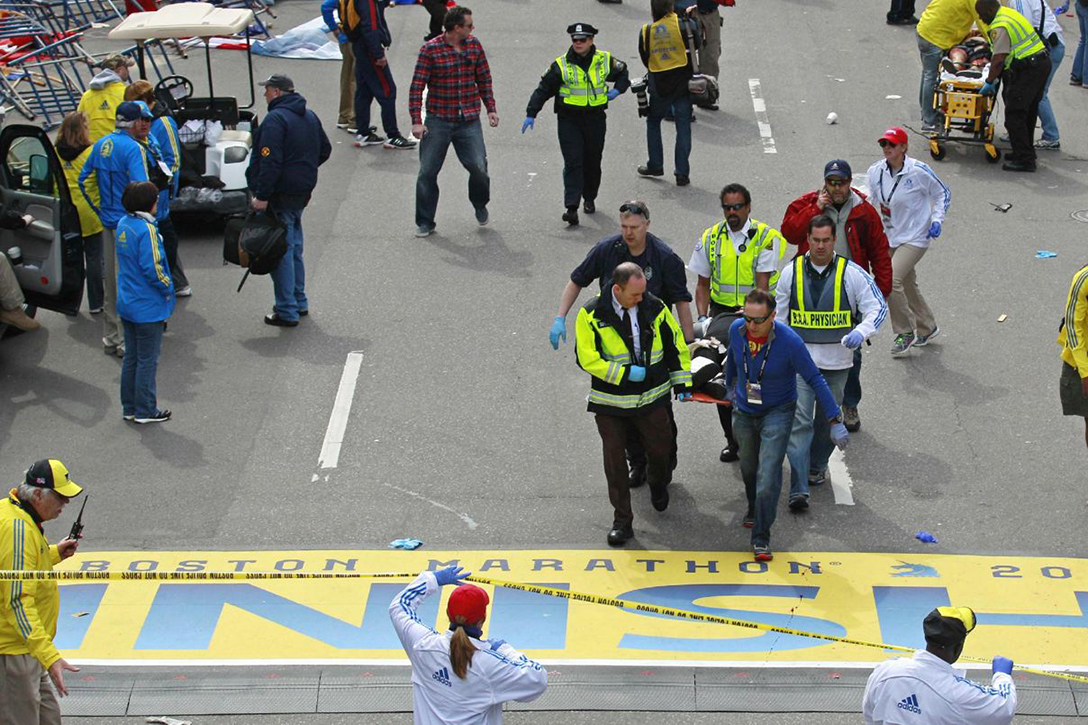
New Cover-up in Boston Bombing Saga — Blaming Moscow (04/10/2014)
Maybe you heard: the Russians are responsible for the Boston Marathon bombing. At least indirectly. That’s what The New York Times says. Had the Russians told the Americans everything they knew about Tamerlan Tsarnaev, the bombing might have been averted by the FBI. The Times knows this because it was told so by an anonymous “senior American official” who got an advance look at a report from the “intelligence community.”
Does New Boston Bombing Report Hint at Hidden Global Intrigue? (04/14/2014)
The US government’s latest report on the Boston Marathon bombing is so full of revealing information buried in plain sight, it seems as if an insider is imploring someone — anyone — to dig deeper. It reads like the work of an unhappy participant in a cover-up.
Todashev’s Killer: No Wonder His Identity Was Secret (05/17/2014)
Doubts about the already controversial shooting of Boston bombing figure Ibragim Todashev in Florida last year are sure to grow with new revelations about the FBI agent who shot him. As WhoWhatWhy previously reported, the case is full of anomalies and part of a larger pattern of harassment against Chechen-Americans who knew accused bombers Tamerlan and Dzhokhar Tsarnaev. Like everything related to the bombing, Todashev’s killing is swaddled in official secrecy and the US government’s latest report about the Boston tragedy shows there was plenty to be secretive about. Emerging details about the FBI shooter’s past cry out for further inquiries about the FBI itself. How could they hire an officer with such a history?
Boston Update: Boston Globe Reports on Its Own Bombing Reporting, Sort of (08/11/2014)
The Boston Globe’s coverage of the Marathon bombing “was marked by an overload of inflammatory themes, words, phrases, and passages,” according to a media content analysis commissioned by Dzhokhar Tsarnaev’s defense team. Predictably, however, the Globe’s portrayal of the study is, well, a little selective. The findings of the analysis, conducted by Edward J. Bronson, a trial venue expert and professor emeritus at California State University-Chico, are laid out in a sworn declaration filed on August 7. It’s part of the defense effort to get the trial moved from Boston.
Boston Update: Is Officer Collier’s Killer Still at Large? (09/26/2014)
After the dust settled in Watertown in the early morning hours of April 19, Massachusetts State Police Superintendent Timothy Alben told reporters at a press conference that the Tsarnaev brothers perpetrated all of the violence that occurred in Cambridge and Watertown that night, including the robbery of the 7-Eleven. During that same press conference he made reference to the photo of Dzhokhar wearing a hoodie, widely circulated by law enforcement, claiming it had been taken by a security camera at the 7-Eleven. Numerous news outlets reported the series of events as exactly that: The brothers committed a robbery at 7-Eleven, shot Officer Collier, hijacked an SUV, and then engaged police in a shootout in Watertown. But there was one glaring problem with Alben’s account, and 7-Eleven’s director of corporate communications picked up on it. She pointed out to reporters later that day what law enforcement already knew: The security video clearly shows the 7-Eleven suspect’s face — and it looks nothing like either Tsarnaev. In addition, she said the photo of Dzhokhar was not even taken at a 7-Eleven store.
Boston Update: FBI War on Marathon Bombing Witnesses Continues (10/02/2014)
Since the Boston Marathon bombing a year and a half ago, the FBI appears to be intimidating, harassing, and silencing friends and acquaintances of the Tsarnaev brothers. Dzhokhar Tsarnaev’s lawyers have noticed it too — they’re having trouble getting anyone to talk to them, recent court papers reveal. In what WhoWhatWhy previously described as the FBI’s “war on witnesses,” the bureau seems to be employing a scorched earth strategy of destroying anything that might be of use to the “enemy.”
Boston Bombing: No Proof Tying Tsarnaevs to Triple Murder, Feds Admit (12/09/2014)
For nearly any crime requiring a “Whodunnit” answer in Boston around the time of the April 15, 2013, Marathon bombing, the authorities answered: the Tsarnaev brothers. One egregious crime pinned on them was a grisly September 11, 2011, triple murder in Waltham, MA. Now, prosecutors in the trial of Dzhokhar Tsarnaev have delivered a shocking reversal. They admit to having no evidence that his dead brother, Tamerlan, was involved in the slayings.

Why Russia Matters to the Boston Bombing Suspect’s Defense (01/26/2015)
A close look at the nature of the information Tsarnaev’s defense team has repeatedly requested from prosecutors in motions to the court suggests Tsarnaev’s lawyers are trying to pry loose something about the government’s relationship with the Tsarnaevs prior to the bombing on April 15, 2013. The key to this relationship may lie in a store of information that the Russians delivered to US investigators in the days after the bombing. Equally, it may be found in warnings Moscow delivered to US investigators before the attack. Either way, the US government has fought hard to keep the lid on what it knows.
Boston Wrong: The Boston Marathon Bombing “Evidence” That Wasn’t (01/29/2015)
Verbal intimations by government officials and a TV re-enactment have given some potential Boston Marathon bombing jurors the mistaken belief they have seen a video of suspect Dzhokhar Tsarnaev setting down a bomb-laden backpack in front of a restaurant. There’s just one problem: That footage has never been made available to the public. During jury selection on January 26, Juror 186 said she believes Tsarnaev is guilty because of the “surveillance video from Lord & Taylor,” a department store across the street from the Forum restaurant. Early media reports suggested that the store’s dome surveillance camera captured Tsarnaev dropping his backpack at the spot of the second explosion.
Why WhoWhatWhy’s Boston Marathon Bombing Coverage Is Important (4/09/15)
At WhoWhatWhy, we specialize in asking hard questions when something doesn’t seem to add up. Now that traditional news outlets have all but abdicated their responsibility to keep our officialdom honest, this seems like an increasingly important mission.
A case in point is the coverage of the Tsarnaev trial by the Boston Globe. You would think such a venerable newspaper would go out of its way to conduct an independent investigation of the government’s claims concerning the 2013 Marathon attack in its hometown, and the massive ramping up of security state authority in its wake.
What’s Not Being Revealed in the Tsarnaev Courtroom (03/30/2015)
The prosecution pulled a couple of astonishing 180°s in the Dzhokhar Tsarnaev trial Thursday. The fancy footwork actually had the government denying evidence it once claimed to have possessed. In fact, in one instance, the prosecution managed to pull a full 360°. It started when one witness, FBI Supervisory Agent Michael Knapp — who works with the Terrorist Explosive Device Analytical Center (TEDAC) in Quantico, Virginia — testified that the bombs allegedly made by Tamerlan and Dzhokhar Tsarnaev were “not that sophisticated.” He also stated that investigators found explosives residue in the Tsarnaev brothers’ Norfolk Street, Cambridge, apartment and in their vehicles. However, both these assertions directly contradict what the public has been led to believe.
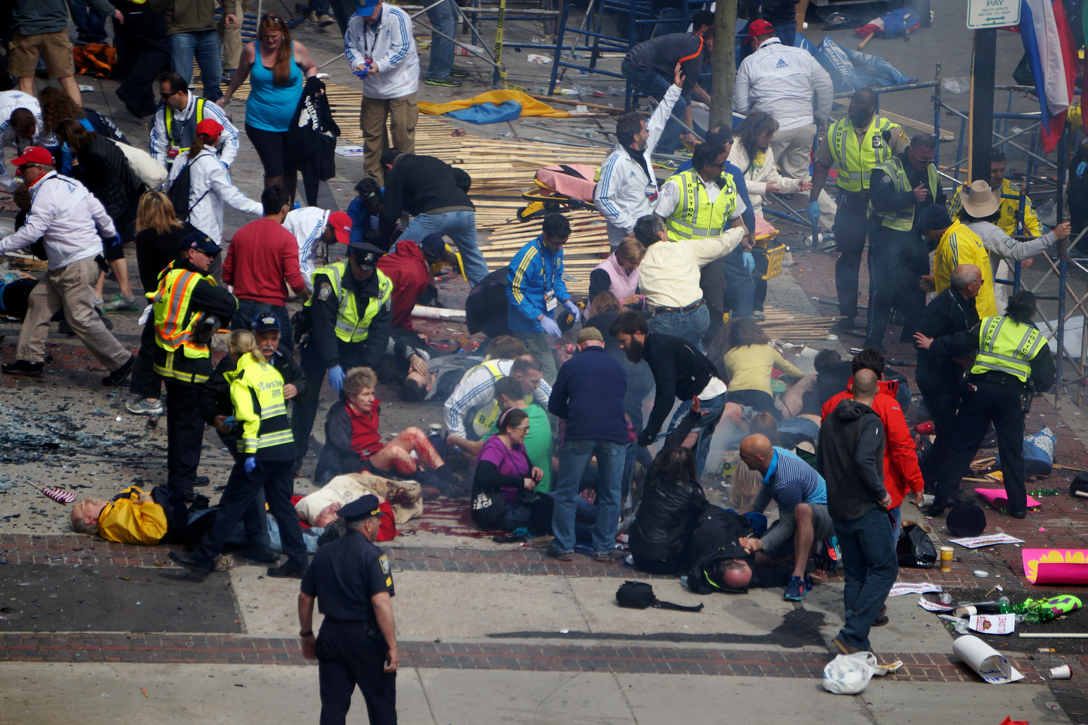
In a deepening of the mystery of Tsarnaev’s relationship with the feds, it turns out there’s an eerie parallel: the FBI’s little-known, pre-bombing relationship with Tamerlan Tsarnaev’s close friend, Ibragim Todashev. Todashev was shot and killed in his Florida apartment by an FBI agent on May 22, 2013, about a month after his friend Tamerlan was killed. Todashev was shot while being questioned, supposedly about his and Tamerlan’s alleged involvement in a 2011 drug-related, triple homicide in Waltham, Massachusetts. But Todashev’s friends say he believed the agents had another motive: they wanted to find out what if anything he knew about Tamerlan’s earlier interactions with the Bureau. In any case, the FBI, other law enforcement agencies, and the mainstream media have told radically conflicting stories of the shooting, none of which has ever made sense.
Tsarnaev Case Judge: FBI Interview Reports Are Unreliable and Cast in Stone (05/20/2015)
The Federal Bureau of Intimidation? The presiding judge in the case against convicted marathon bomber Dzhokhar Tsarnaev warned jurors last week against automatically assuming the reliability of FBI interview reports. US District Court Judge George O’Toole’s admonition inadvertently bolstered long-standing criticisms of FBI interview practices — that the FBI creates its own “truth” by refusing to electronically record interviews, and then forcing witnesses to go along with it using threats of jail time under the federal “making false statements” statute.
Missing Evidence of Prior FBI Relationship With Boston Bomber (06/06/2015)
Ever since the early days of the Boston Marathon bombing investigation, it’s been commonly understood that Tamerlan Tsarnaev first came to the attention of the FBI thanks to a March 2011 “warning” from the FSB, Russia’s security services. We now know this to be false. In a little-noticed exchange during congressional testimony, the FBI’s then-Director Robert Mueller admitted that the bureau had an interest in the elder Tsarnaev before Russia’s warning. That crucial admission has somehow become buried over time, and the government has been only too happy to leave it out of sight.
The Boston Bombing Anniversary: A Legacy of Unanswered Questions (04/17/2016)
At the trial, his government-appointed counsel stated that he was guilty, and he himself admitted his guilt, and said that he was sorry. But that is all he said. To this day he has never explained how he and his brother ever became terrorists. He couldn’t tell us if he wanted to. Since his arrest he’s been held under unusual Special Administrative Measures (SAMs), which prevent him from communicating with the outside world. Strikingly, SAMs have also been imposed on his attorneys. The government maintains that SAMs are necessary to prevent prisoners from inciting others to commit acts of terrorism. But what others? The FBI insists the two brothers were lone wolves, unconnected to any larger network. Family members say they were told to keep their mouths shut. And they were warned not to challenge the credibility of the investigation or the prosecution.
DOJ Cites Bizarre Reason to Deny WhoWhatWhy Access to Tsarnaev Info (04/21/2016)
On the grounds that it wants to protect the privacy of convicted Boston Marathon bomber Dzhokhar Tsarnaev, the Department of Justice (DOJ) has stymied attempts by WhoWhatWhy to find out if Tsarnaev is still being held under Special Administrative Measures (SAMs). SAMs are a repressive type of confinement that severely limits one’s ability to communicate with anybody outside of one’s prison cell. DOJ claimed that without Tsarnaev’s consent, revealing such information about the prisoner’s status “could reasonably be expected to constitute an unwarranted invasion of [his] personal privacy.” This was in response to a Freedom of Information Act request filed by WhoWhatWhy, seeking updated details of Tsarnaev’s confinement.
Tamerlan Tsarnaev’s Immigration Records Reveal FBI Bombshell (05/11/2016)
WhoWhatWhy has discovered that the FBI secretly flagged at least one of the “Boston Marathon bombers” as a terrorist threat in his immigration records, despite publicly denying it had done so. This designation existed right up to the time the bombs went off at Boylston St. on April 15, 2013. Tamerlan Tsarnaev’s heavily redacted immigration records, known as an A-file (alien file), were released in February under the Freedom of Information Act and posted online by US Citizenship and Immigration Services (USCIS). FOIA has a “frequently requested record” provision where multiple requests for the same record triggers a “reading room” (posted online) treatment of the records. WhoWhatWhy was one of those requesters.
Glenn Beck Ordered to Reveal Who Fed Him Boston Bombing Disinfo (09/07/2016)
In what’s being called “a First Amendment showdown,” a federal judge has ordered conservative radio personality Glenn Beck to reveal two of his sources in a defamation case related to his reporting of the Boston Marathon bombing. Beck, quoting high-level law enforcement officials, reported that a young Saudi, Abdulrahman Alharbi, was the “money man” and gave the “go order” to the perpetrators of the bombing.
‘Boston Marathon Bombing Cover-Up: A Conversation with Michele McPhee (04/15/2017)
In this podcast with Jeff Schechtman, Michele McPhee, longtime Boston investigative journalist and author of the book Maximum Harm fingers Tamerlan Tsarnaev as an FBI informant gone rogue. She also discusses the role that the US intelligence community played in covering up the key fact that Tamerlan Tsarnaev was one of its protected “assets.”
DOJ Continues to Block Media Access to Tsarnaev (10/25/2017)
For over two years, WhoWhatWhy tried to get the government to give us the details of the justification behind incarcerating convicted Boston Marathon bomber Dzhokhar Tsarnaev under a repressive confinement regime known as Special Administrative Measures (SAMs). SAMs make it nearly impossible for the media to have any access to prisoners. WhoWhatWhy twice submitted requests to interview Tsarnaev to the warden of the maximum-security federal penitentiary in Florence, CO, referred to as ADX Florence. We sent one in October 2015, and another in August 2017; both times we were told we could not interview him because “inmate Tsarnaev has Special Administrative Measures,” which, among other things, “restricts [his] communication, to include contact with the media.”
Dzhokhar Tsarnaev Still Gagged as Death Penalty Appeal Grinds On (4/17/2018)
Dzhokhar is being held at the maximum-security federal penitentiary in Florence, CO — known as the “Alcatraz of the Rockies” — under extreme confinement conditions called Special Administrative Measures (SAMs). Essentially a form of solitary confinement, SAMs prevent inmates from communicating with all but a few pre-approved individuals. Tsarnaev is not even allowed to communicate with other inmates in the facility. The government justifies the imposition of SAMs by pointing to the possibility that Tsarnaev could try to secretly communicate with criminal compatriots or incite violence of one kind or another. It’s not clear who that might be, since the government insists that Dzhokhar and his brother Tamerlan acted on their own.
Boston Bomber in Court but Full Story Still Muzzled (12/12/2019)
A court in Boston heard arguments on Thursday from lawyers for convicted Boston Marathon bomber Dzhokhar Tsarnaev. His defense team argued that he had not had a fair trial and deserves a new one. Tsarnaev is being held at the federal supermax prison in Florence, CO, where he faces the death penalty.
WhoWhatWhy was among the very few news outlets to ask these questions and to dig deeper than the accepted narrative — and published more investigative pieces on this topic than any other: 70+ articles and podcasts. The cumulative work we did clearly shows that there is much more to this story than what the public has been told. Here are some of the remaining questions that need attention.
